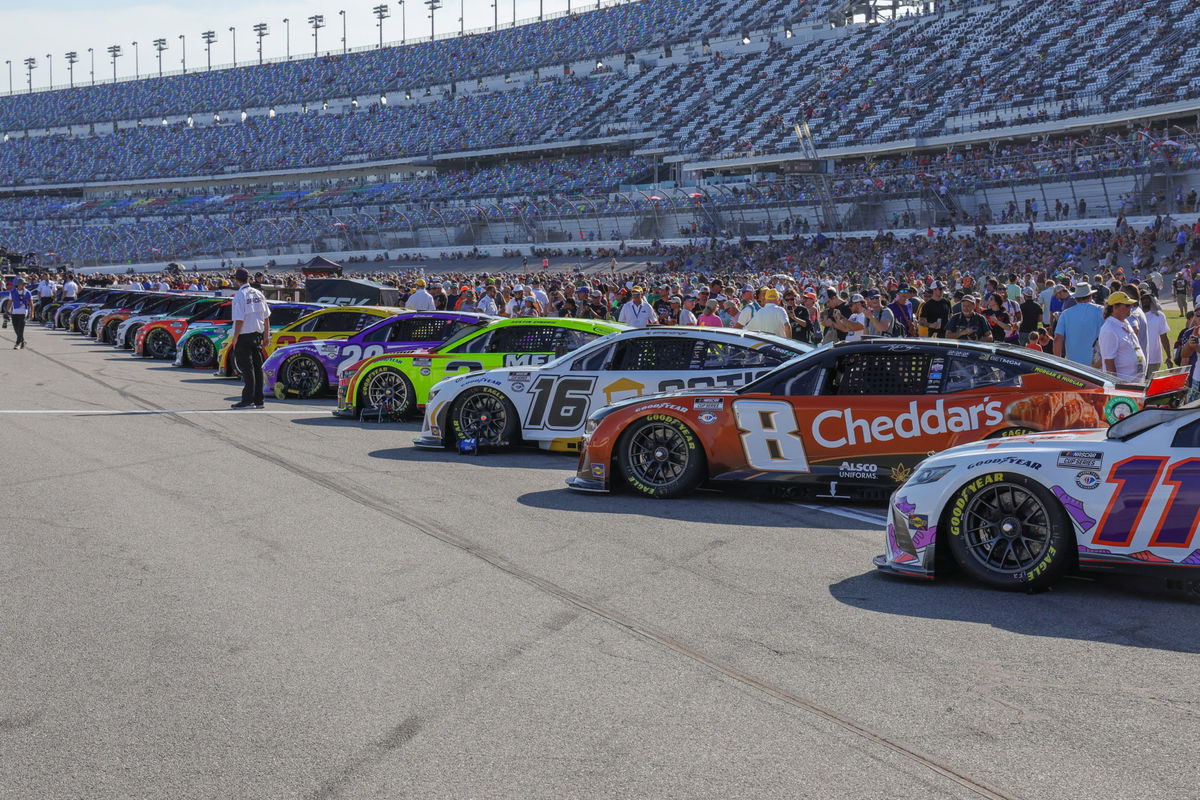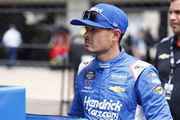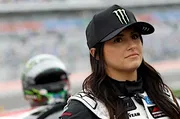
USA Today via Reuters
Aug 26, 2023; Daytona Beach, Florida, USA; NASCAR Cup cars on display for fans before the Coke Zero Sugar 400 at Daytona International Speedway. Mandatory Credit: Mike Watters-USA TODAY Sports

USA Today via Reuters
Aug 26, 2023; Daytona Beach, Florida, USA; NASCAR Cup cars on display for fans before the Coke Zero Sugar 400 at Daytona International Speedway. Mandatory Credit: Mike Watters-USA TODAY Sports
Why are NASCAR teams suddenly inking massive deals with streetwear and apparel giants? Not too long ago, 23XI Racing unveiled its Jordan Brand firesuit to wild excitement. This marketing route sparked curiosity not only because of its focus on apparel, but also because of what it represents: a full-scale cultural confrontation. NASCAR teams now spend the rest of the week walking runways, from limited-edition pit crew drops to custom sneakers.
Watch What’s Trending Now!
Once proud of motor oil and mullets, the sport is now experimenting with luxurious designs and a new generation of buyers. But something much more strategic is hidden behind the aesthetics and logos. This is a survival tactic, not only a branding fad. In the current NASCAR economy, it’s also changing the way teams, sponsors, and even drivers interpret value.
ADVERTISEMENT
Coofandy eyes NASCAR market amid growing motorsports push
A Hong Kong-based clothing brand that is more well-known for exquisite casual wear than speedways is preparing to launch a high-profile entry into the NASCAR universe. Coofandy, a rapidly expanding fashion brand well-known on social media and Amazon for its affordable, well-tailored men’s necessities, is hinting at a significant brand ambassador launch related to motorsports. The brand featured a silhouetted race car driver with the slogan, “Dress the Win,” along with the words, “COOFANDY | 10ᵗʰ” and “Global Brand Ambassador Launch,” in a social media post this week. With hazy stock car graphics that suggest NASCAR, the image suggests a racing collaboration.
.@Coofandy, an apparel company based in Hong Kong, has been talking with @NASCAR Cup teams in recent months about a possible deal, per sources, and is now promoting an upcoming announcement.
➡️ Coofandy also started advertising with Fox Sports’ NASCAR coverage in recent weeks. pic.twitter.com/x4n9KW518B
— Adam Stern (@A_S12) May 25, 2025
More significantly, Sports Business Journal was informed by people with knowledge of the matter that Coofandy has been in discussions about possible marketing or sponsorship deals with many NASCAR Cup Series teams in recent months. Although details are still being kept under wraps, the clothing company’s approach seems to be in line with NASCAR’s continuous efforts to draw in lifestyle brands that appeal to audiences outside of the conventional motorsports market.
ADVERTISEMENT
Fashion and lifestyle brands are increasingly using NASCAR’s changing image, which aligns with Coofandy’s timing. Coofandy’s involvement is a natural next step in the sport’s evolution, which now aims to reach a younger, more diversified fan base through influencer partnerships, streetwear partnerships, and digital content. Coofandy, which was founded in 2015, established its brand online, mostly through Amazon and other online marketplaces, and became well-known for its stylish yet reasonably priced clothing. With the opportunity to reach millions of fans at the track and through national broadcasts, the company’s foray into motorsports represents a calculated move into the U.S. sports marketing industry.
Over the past five years, NASCAR has opened itself to lifestyle and non-endemic businesses more and more. As part of its larger goal to diversify its fan base, the league has recently partnered with fashion-forward businesses and entertainment properties. In recent years, there have been noteworthy collaborations between automotive, gasoline, and tool brands and fashion-forward labels like Puma with Trackhouse Racing’s Project91.
ADVERTISEMENT
Coofandy’s action indicates a desire to become part of NASCAR’s cultural revival in addition to advertising. Earlier this season, the company tested its audience alignment covertly by starting to advertise on FOX Sports’ NASCAR broadcasts. According to the new ambassador campaign, Coofandy is prepared to advance that partnership. Online rumors have been sparked by the Coofandy promotional image that was issued this week, which shows a motorist wearing a helmet but lacking any distinguishing characteristics. Could it be a current Cup Series driver or a crossover personality with a background in motorsports?
Together with the company’s logo for its tenth anniversary, the image’s “COOFANDY X?” tag suggests a big name reveal that might extend beyond a simple marketing campaign. It might entail an official team association, merchandising capsule, or livery alliance. Such a brand partnership would be ideal given the off-track manner of fashion-forward driver personalities like Ryan Blaney, Tyler Reddick, and Daniel Suárez. The campaign’s goals might also be met by a celebrity ambassador with a connection to racing, like Travis Pastrana, or a music industry star with NASCAR ancestry.
Coofandy’s fascination with NASCAR is indicative of a larger shift in racing marketing. International marketers are increasingly using U.S. racing leagues as a platform to explore direct-to-consumer tactics. A presence in American athletics gives the possibility of strengthening brand loyalty through lifestyle storytelling, even if Coofandy has mostly established its business online.
ADVERTISEMENT
Industry observers will be curious to see where and with whom Coofandy will plant its flag as the announcement is anticipated in the upcoming weeks. The company would be among the first significant international menswear brands to partner with a NASCAR franchise on this magnitude if it were to execute on a team contract. For now, the question remains: Who is the mystery ambassador under the helmet? And what exactly does Coofandy’s next phase look like on the racetrack? Whatever the answers, one thing is clear—NASCAR’s growing intersection with lifestyle branding just found its latest runway partner.
Top Stories
Footage Surfaces of Florida Police Arresting NASCAR Veteran Over Disturbing Public Misbehavior

Denny Hamlin Demands Immediate Apology From FOX Broadcaster After Michael Jordan’s Lawsuit Triumph

Jeff Gordon’s Wife Ingrid Vandebosch Shares Tearful Message Amidst Major Family Announcement

Kyle Larson’s Sprint Car Rivals Threatens Criminal Action Against Track Owner Over $15,000 Winner’s Purse

Hailie Deegan & Others Speculated to Fill NASCAR Seat After Star Driver’s Ugly Exit

NASCAR’s sponsorship game evolves in the streaming era of Amazon
The sponsorship industry is changing dramatically as NASCAR enters a new media era, which is highlighted by its historic agreement with Amazon. Teams throughout the garage are adjusting to a more digitally driven and metrics-focused marketing environment as streaming transforms how fans interact with content. Rick Ware, owner of Rick Ware Racing, captures the current tone across the paddock: “The marketing side of it is very bullish right now,” he said. “We’re obviously one of the smaller teams, and we’re having dramatically more conversations than we typically have in the past. That doesn’t mean that you close them all, but the interest is there.”
ADVERTISEMENT
As an illustration of how even underdog teams are becoming more popular in this changing sponsorship market, Ware’s team just signed a 12-race contract with Arby’s. It reflects a larger trend: sponsors are now more interested in content alignment, storytelling, and ROI supported by data than they were in brand placement alone. Amazon’s inclusion in NASCAR’s broadcast portfolio, which started this season, is intimately related to that change. Amazon’s impact tends to change the models of engagement and viewing, as is evident in other sports like the NFL’s Thursday Night Football. Executives and teams in NASCAR are placing bets on comparable expansion.
“Sponsors are very intrigued by Amazon,” said Mike Verlander, president of Richard Childress Racing. “Now, we have no result back yet, so let’s see what the result looks like. But you see what they did with the NFL. It’s only grown. We expect the same.” Verlander acknowledges the growing pains that can come with media disruption, “Is it tough because the avid fan has to now figure out where to find it? Yeah,”—but he sees long-term upside. “At the end of the day, I think it’s an all-positive narrative because there’s new players that are putting their stake into this.”
At the team level, organizations are reconfiguring how they present themselves to potential partners. Eric Schaffer, chief commercial officer at Joe Gibbs Racing, emphasized how data is reshaping the sponsorship pitch. “The models are changing in terms of what people are looking for, and so JGR has adapted,” he explained. “We’ve added a marketing group that we didn’t have before. People are focused on data and absolutely getting a return on their investment. It’s certainly not a sticker on the car anymore—it’s an integrated marketing program.” Digital content, hospitality experiences, fan interaction activations, and access to NASCAR’s growing global platforms are all included in this connection. Delivering value beyond conventional impressions is the clear objective.
ADVERTISEMENT
Supported by Denny Hamlin and Michael Jordan, 23XI Racing has been a pioneer in utilizing brand identity in the contemporary media landscape. 23XI Team president Steve Lauletta pointed to a broader industry trend: “The marketers know that’s the path of where audiences are going,” he said. “So this isn’t a one-year light switch—it’s going to be more of a dimmer to try to keep growing and follow the audience as it grows.”
NASCAR’s teams are vying to stay ahead of the curve as the organization adapts to a media landscape that is splintered but full of opportunities. Versatility, agility, and making every lap matter in the boardroom as much as on the track are key components of the new sponsorship age, which goes beyond visibility.
ADVERTISEMENT
ADVERTISEMENT
ADVERTISEMENT
ADVERTISEMENT

